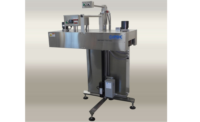Automation
Sanitary Equipment Design for the Times
Two companies offer tips on what to look for in sanitary equipment and how it can help to reduce product recall and improve productivity.

Sanitary equipment is used in food, pharmaceutical, meat and dairy packaging applications religiously. In times like these — during a pandemic or other situations that threaten food safety — it is of utmost important to know what you need. Here, we talked with two packaging machinery suppliers that offer sanitary machines on what to look for when seeking cleanable equipment.
Q. What tips do you suggest looking for in cleanable equipment?
Craig Souser, president and CEO, JLS Automation, offers these tips:
- Look for harborage points where food and other items can build up: Where can water puddle? Are there points to be cleaned that are hard to reach or cannot come apart for extensive cleaning? How easy is it to clean in place as well as clean out of place? Do the conveyors have belt lifters? Are the cabinets sloped? Does the equipment make use of stand offs?
- The AMI, now NAMI checklist is a great tool for comparing equipment and is literally a scorecard. Have the OEM self-score and then do your own score.
- Ask for a cleaning process or section of the manual for a machine — does it exist? Do they have videos of the machine being cleaned?
- Is the design simple visually or does it have a bunch of parts that have to be used to change patterns or guide products or packages?
- Vision-guided equipment typically has a lot fewer items to deal with, so is your desired application being addressed by a vision-guided provider?
Next, Mark Navin, vice president of sales at Spee-Dee Packaging Machinery offers these tips:
Follow 3-A sanitary standards. In our case, that is standard 27-07, equipment for packaging dry products.
- Make sure there are no fasteners in the product area.
- No cracks or crevices that would be difficult to clean.
- No threads, which are also difficult to clean.
- No flat surfaces to collect product or water.
- Do have continuous smooth radiused welds.
- Toolless removal of components for cleaning.
Q. How can sanitary design improve your bottom line, help lower the risk of product recall and improve productivity?
Souser: Sanitary design definitely helps improve your bottom line. It should make a machine simpler to service and take less time to clean. A clean machine — one that facilitates cleaning — improves productivity and lowers recall risk as it will get clean when it is supposed to be without as much effort (lower cost and lower risk). It takes a commitment to make it sanitary, not just capable of being washed, but sanitary or hygienic where it is easy to clean.
Navin: Sanitary augers don’t really improve the bottom line regarding speed and productivity. Our sanitary auger doesn’t run faster than our standard design. Our design may allow faster changeover due to the no tools design and faster cleaning, since we have eliminated all the harborage points. That sanitary design is intended to guard against product contamination and possible product recalls. The recall is an obvious hit on the bottom line. Sanitary design also protects the customer, which is very important to manufacturers.
JLS Automation supplies simple, easy-to-use hygienic robotic packaging solutions for the food industry that solve complex packaging challenges. Designed for sanitary environments, JLS custom vision-guided primary and secondary robotic packaging systems are user-friendly, easy to operate, fast to start-up and ensure both worker and food safety.
Spee-Dee Packaging Machinery supplies filling solutions and checkweighers for the food, pharmaceutical and nutraceutical industries. Designed for specific applications with simplicity in mind, Spee-Dee systems achieve accurate, reliable filling and weighing, and are backed by a commitment to service and quality.
Looking for a reprint of this article?
From high-res PDFs to custom plaques, order your copy today!







